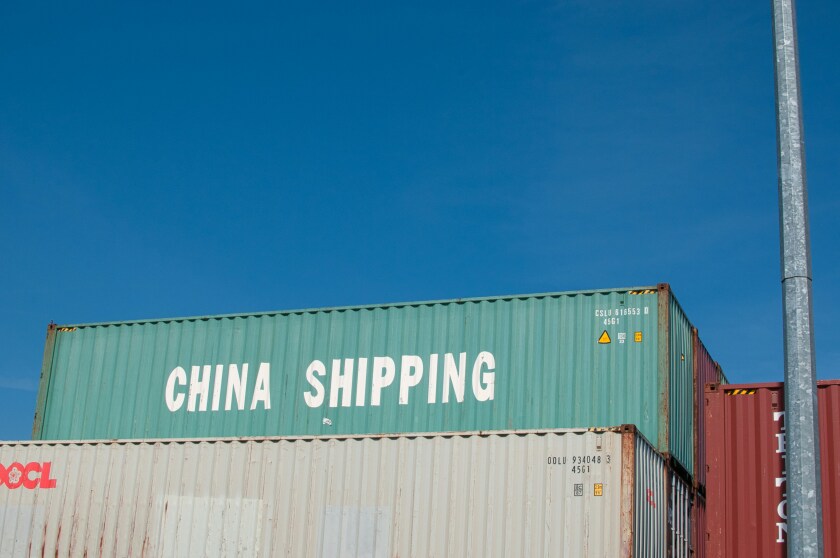Customs protection of intellectual property rights in China (also known as border protection of intellectual property rights) originated from the Sino–US Memorandum of Understanding on the Protection of Intellectual Property signed in 1992. Article 5 of the memorandum states: "The two Governments shall take effective measures and remedies within their respective borders to avoid or deter infringement of intellectual property rights."
In September 1994, the General Administration of Customs of China (GACC) issued the Notice on Strengthening the Protection of Intellectual Property Rights in Customs Supervision, requiring local customs offices to take administrative measures to investigate and punish cases of infringement of intellectual property rights concerning the importation or exportation of goods.
In October 1995, China implemented the Regulations of the People's Republic of China on Customs Protection of Intellectual Property Rights, officially starting to establish a border protection system for intellectual property rights in line with the rules of the World Trade Organization (WTO).
In 2001, China joined the WTO and began to fully implement the Agreement on Trade-Related Aspects of Intellectual Property Rights (TRIPS).
On December 2 2003, the State Council of the People's Republic of China promulgated new Regulations of the People's Republic of China on Customs Protection of Intellectual Property Rights, which came into force on March 1 2004.
According to the regulations, Chinese customs shall protect the exclusive right to use trademarks, copyrights, and copyright-related rights and patent rights related to import and export goods and protected by China’s laws and administrative regulations.
The prerequisite for the protection of intellectual property rights by customs is that the intellectual property rights are recorded at the GACC, and the prerequisite for the customs recordation is that the intellectual property rights holder has obtained trademark registration, copyright registration, or patent authorisation in China. Although China implements the principle of voluntary copyright registration, copyrights that have not been registered and obtained copyright registration certificates cannot be registered at the GACC.
Characteristics of the intellectual property customs protection system in China
The nature of customs protection of intellectual property rights in China is administrative relief. According to the foreword of TRIPS, the agreement requires all member countries to recognise intellectual property rights as private rights.
China's legislation is consistent with TRIPS and fully recognises the nature of intellectual property rights as private rights. However, from the aspects of the content of customs protection of intellectual property in China, and the nature, procedures, and results of law enforcement, the system protects private rights by public power; that is, the protection of intellectual property by means of administrative remedies.
Chinese customs is the country's entry and exit supervision and management organ, on behalf of the state, to exercise import and export supervision and management functions of the administrative organs. With regard to the law enforcement procedures of customs, when intellectual property rights registered with customs are infringed, Chinese customs can take the initiative to protect them in accordance with its authority, without the need for an application from the intellectual property rights holder. Moreover, the administrative remedy means of customs is mainly to detain suspected goods, and the right of detention is the expression of public power.
The protection of intellectual property rights by Chinese customs can be divided into two forms:
Protection on application; and
Ex officio protection.
Protection on application means that when the intellectual property right holder discovers that the suspected infringing goods are about to be imported or exported, it submits an application to customs for taking protective measures in accordance with the provisions of articles 12, 13, and 14 of the Regulations of the People's Republic of China on Customs Protection of Intellectual Property Rights, and customs shall detain the suspected infringing goods. Since customs does not investigate suspected infringing goods detained on application, the intellectual property rights holder needs to file a lawsuit before a people's court concerning the relevant infringement dispute, so protection on application is also called a ‘passive protection’ mode of customs regarding intellectual property.
Ex officio protection means that when customs finds in the course of supervision that import or export goods are suspected of infringing the intellectual property rights registered with the GACC, in accordance with the provisions of Article 16 of the Regulations of the People's Republic of China on Customs Protection of Intellectual Property Rights, it takes the initiative to suspend the customs clearance procedures of the goods and notify the relevant intellectual property rights holder, and detain the suspected infringing goods according to the application of the intellectual property rights holder. Since customs detaining suspected infringing goods by authority is an initiative to stop the importation and exportation of infringing goods, and customs also has the right to investigate infringement situations involving goods and punish the parties concerned, protection by the authority is also called the ‘active protection’ mode of customs on intellectual property rights.
Application for customs recordation and the protection process
The Intellectual Property Protection Department of the Department of Policies and Regulations of the GACC is responsible for accepting and approving an application for customs recordation of intellectual property rights, and after approval, local customs bodies shall implement the customs protection of intellectual property rights.
The information and documents that intellectual property rights holders are required to submit when filing an application for customs recordation are as follows.
A copy of the business registration certificate of the intellectual property right holder.
A copy of the intellectual property rights certificate – a trademark registration certificate, a patent certificate, a copyright registration certificate, etc.
A colour scanned copy of the power of attorney – if an agent is entrusted to handle the customs recordation, a colour scanned copy of the power of attorney must be submitted, providing the name, title, telephone number, and email address of the signatory of the power of attorney.
If the intellectual property rights holder has manufacturers, importers, or exporters legally authorised to use the registered intellectual property rights in China, the following information can be provided to add these manufacturers, importers, or exporters to the legitimate user list of customs recordation to ensure the smooth importation and exportation of goods:
Authorisation period – limited to the authorisation period of the intellectual property rights certificates;
Scope of authorisation – limited to the scope of the intellectual property rights certificates; and
Other information – the name of import and export customs, cargo details, etc.
In practice, if the legitimate user list is not added in time, the local customs office will also take temporary suspension measures regarding the authorised import and export goods, and require the intellectual property rights holder to confirm. Even if the intellectual property rights holder confirms and requests the release of the goods within a short period, the goods will be delayed for some time due to the internal documentation and signature process of customs, and for goods with a very close shipment date, the shipment time could be missed. Therefore, the timely and standardised addition of the legitimate user list is also a very important part of customs recordation.
After registration and approval of the intellectual property by customs, the local customs office will inspect and seize the suspected infringing goods for importation or exportation in accordance with the approved information. For goods that are temporarily seized, the local customs office will issue a notice of confirmation of intellectual property status to the intellectual property right holder or its agent, requiring the intellectual property right holder or its agent to confirm to customs whether the goods are genuine within three days after receiving the notice. The notice includes the following contents:
The name of the importer or exporter;
The name of the intellectual property rights allegedly infringed;
The name and quantity of the import or export goods;
The destination of the goods; and
The amount of the security fee.
Usually, customs will also provide photos of the detained goods to the intellectual property rights holder or its agent for their confirmation, or, with the consent of customs, the intellectual property rights holder can also send someone to the local customs office to inspect the goods on their own.
Different from the customs recordation of other intellectual property rights, when the goods detained by customs are suspected of patent infringement, the consignee or consignor of the suspected infringing goods may consider that the import or export goods do not infringe the patent right and may request customs to release the goods after providing customs with a security fee for the goods. Thereafter, if the intellectual property right holder fails to file a lawsuit with a people's court within a reasonable period, customs shall return the security fee to the consignee or consignor.
In the case of protection on application, customs will investigate whether the detained goods are infringing upon the receipt of the application for customs protection from the intellectual property rights holder. If the detained goods are eventually identified as infringing goods by customs, customs will make an administrative penalty decision and a final notice to deal with the infringing goods, and impose administrative fines.
In addition, before the completion of a customs investigation, the parties can reach a settlement. The content of the settlement generally includes:
That the owner of the goods admits that the goods infringe the intellectual property rights of the intellectual property right holder;
That the owner of the goods may take back the goods after removing the infringing trademarks or infringing contents on the goods;
A written undertaking that the owner of the goods will not infringe upon the intellectual property rights of the right holder any more; and
The payment of damages.
Problems encountered in practice
In the past year or two, the GACC has put forward new requirements for an intellectual property owner or its agent to register an account before filing an application for customs recordation; that is, requiring the intellectual property owner or its agent to register in the GACC’s ‘Internet+’ before registering an account on the customs filing page.
In particular, for foreign rights holders, foreign names can be used when registering accounts in the GACC system. This is particularly useful for rights holders that do not have registered entities in China and want to record their international registration trademarks, because it is very convenient to directly use the business name in a foreign language on the international registration certificate to register and record accounts.
However, since the second half of 2023, the GACC has imposed new requirements regarding the username of a registered account; namely, it must be registered in Chinese and provide a business name in the foreign language. If registration is not made with the Chinese name, the application for account registration will be rejected. In other words, foreign intellectual property rights holders that meet the above criteria need to provide a Chinese translation of the business name in a foreign language when registering the account.
In addition, in accordance with the relevant provisions of the Regulations of the People's Republic of China on Customs Protection of Intellectual Property Rights, international registration trademark holders are required to submit a certified copy of the trademark(s) when filing an application for customs recordation. According to an announcement by the Trademark Office of the State Administration for Industry and Commerce, since April 22 2016, it has changed the method of issuing a certified copy of a trademark registration; that is, a ‘special seal for the trademark registration certificate’ is now affixed on the printed copy of the trademark record. The printed copy of the trademark record is available immediately and is free of charge.
Therefore, in the following period, many intellectual property rights holders or their agents use the trademark record as a document proving the trademark holder’s right to file the application for customs recordation. However, starting from the second half of 2023, the GACC still requires the submission of a colour scanned copy of the certified copy of the trademark registration when examining an application for customs recordation of an international registration trademark, and an application not submitting a colour scanned copy of the trademark record will be rejected.
For an international registration trademark, because the renewal information is usually not displayed on the WIPO’s website before the expiry date of the trademark, or even if the WIPO’s website displays the renewal information but the Chinese Trademark Office's examination procedure has not been completed, it is not possible to produce the certified copy of the trademark registration before the expiry date. Customs recordation has no grace period, so once the trademark expires, the customs recordation will automatically become invalid.
To avoid the expiry of customs recordation due to non-renewal, the author suggests that trademark owners try to use trademarks registered in China for customs recordation, to ensure the consistency of customs recordation, and to avoid the ‘break’ of customs recordation affecting local customs inspection of suspected infringing goods.












